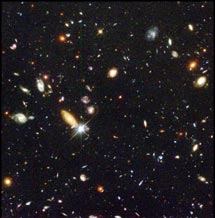
Handy Links
SLAC News Center
SLAC Today
- Subscribe
- Archives: Feb 2006-May 20, 2011
- Archives: May 23, 2011 and later
- Submit Feedback or Story Ideas
- About SLAC Today
SLAC News
Lab News
- Interactions
- Lightsources.org
- ILC NewsLine
- Int'l Science Grid This Week
- Fermilab Today
- Berkeley Lab News
- @brookhaven TODAY
- DOE Pulse
- CERN Courier
- DESY inForm
- US / LHC
SLAC Links
- Emergency
- Safety
- Policy Repository
- Site Entry Form

- Site Maps
- M & O Review
- Computing Status & Calendar
- SLAC Colloquium
- SLACspeak
- SLACspace
- SLAC Logo
- Café Menu
- Flea Market
- Web E-mail
- Marguerite Shuttle
- Discount Commuter Passes
-
Award Reporting Form
- SPIRES
- SciDoc
- Activity Groups
- Library
Stanford
Around the Bay
Happy Birthday, Dear Telescope
Nearly 400 years ago, Galileo Galilei pointed a narrow tube with two carefully cut bits of glass on its ends at a pinprick of light in the night sky. He immediately saw that Jupiter has company in its swing around the sun, and single-handedly (but dual-lensedly) invented the field of observational astronomy.
To celebrate, the International Astronomical Union is throwing the telescope a year-long birthday party by declaring 2009 the International Year of Astronomy. Public outreach events and activities will be held around the world all year to generate interest and commemorate astronomy's accomplishments.
The telescope has come a long way in 400 years. From a hand-held tube with hand-ground lenses, it has grown to encompass such monoliths as the in-progress Large Synoptic Survey Telescope and the Fermi Gamma-ray Space Telescope.
Though it was sufficient to see Jupiter's moons and Venus's phases, Galileo's best model could only magnify objects about 30 times. The LSST, equipped with a mirror 8.4 meters in diameter and a 3200 megapixel digital camera, will catalog billions of distant galaxies when it's complete. As a partner in the 22-member LSST collaboration, the Kavli Institute for Particle Astrophysics and Cosmology leads the work to design and build the telescope's camera—the largest digital camera in the world. The LSST will take pictures of the entire visible sky every few nights, all from the comfortable surface of the Earth.
FGST abandoned the Earth altogether, stretching Galileo's definition of "telescope" even further. Last June, it left the protective cocoon of the atmosphere and settled into orbit, where it scans the universe for high-energy gamma-rays springing from objects like black holes and pulsars. SLAC researchers managed the development of the Large Area Telescope, one of two instruments onboard FGST, and runs the operations center that processes the LAT data. FGST is already sending back news of previously unknown astronomical beasts, like the first gamma-ray-only pulsars.
Galileo would be proud.
óLisa Grossman
SLAC Today, January 29, 2009
For instructions to build your own model of Galileo's telescope for less than $50, see Building a Galilean Telescope. See also Making A Replica of Galileo's Telescope.
